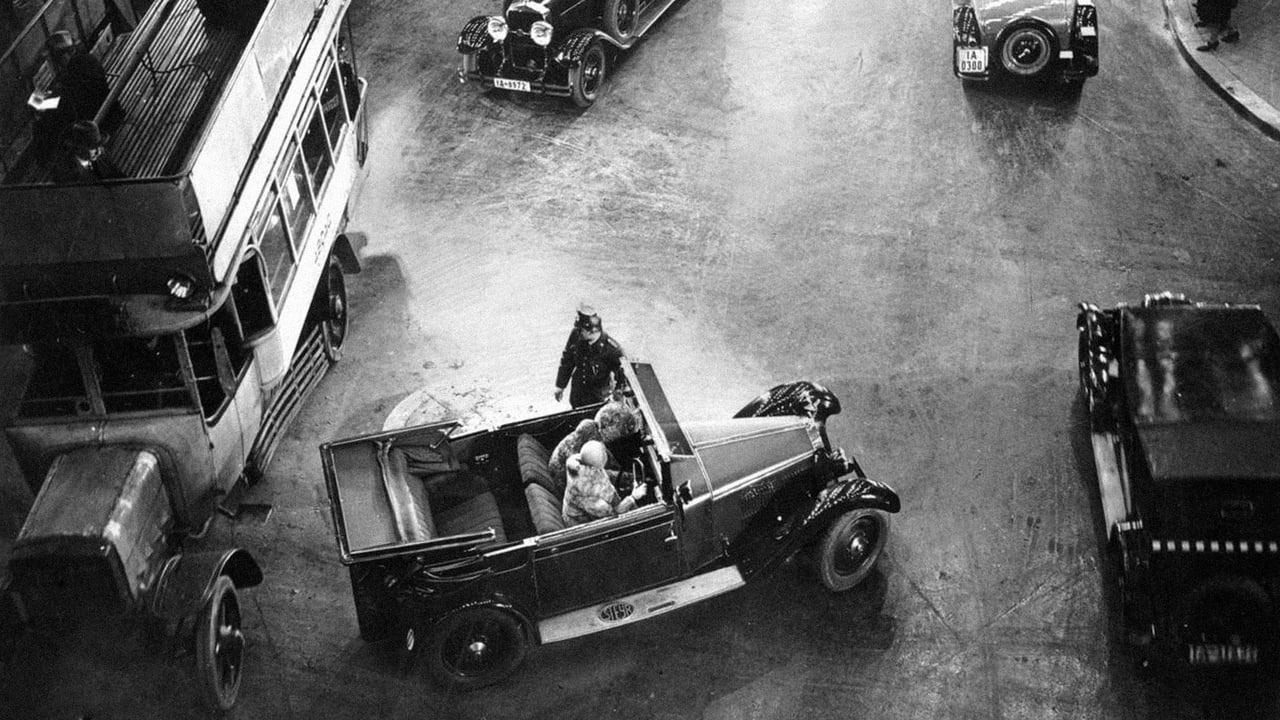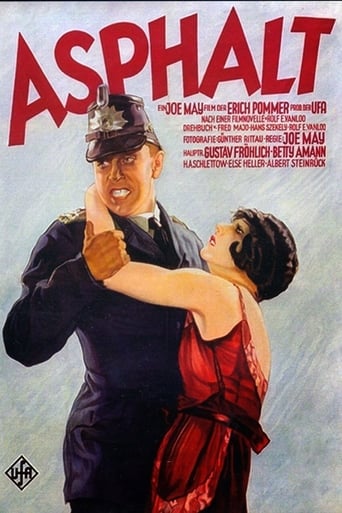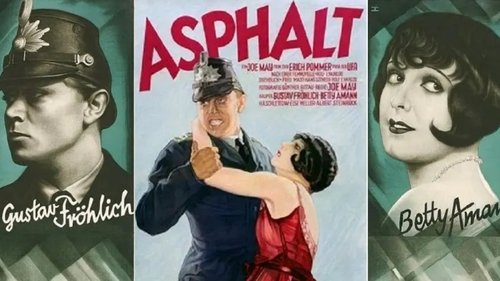


Did you people see the same film I saw?
... View MoreA Brilliant Conflict
... View MoreWhen a movie has you begging for it to end not even half way through it's pure crap. We've all seen this movie and this characters millions of times, nothing new in it. Don't waste your time.
... View MoreThe story, direction, characters, and writing/dialogue is akin to taking a tranquilizer shot to the neck, but everything else was so well done.
... View MoreIts hard to like 'Asphalt' simply because the lead characters are so unlikeable. A policeman who is too weak to stand by his moral compass falls for a seductive jewel thief. The film consists of his attempts to refrain from her seductions, feeling low after his failures, then going back only to fail again. It is fine for half an hour or so (the first half hour is the best), but becomes tedious and quickly loses momentum. It doesn't help that these femme-fatale stories were so overdone already.The most winning aspect of this film is the technical achievements. After a shaky Vertov-esque beginning, it quickly becomes sleek and controlled, very modern. The noir cinematography is typically excellent for the German silents of the time. Despite these virtues however, it is not a story that moves you in any way, except to strong dislike of the characters.
... View MoreIt's a good film all around, but it's most notable for finding yet another remarkable silent beauty queen, Betty Amann, who could perhaps have been a huge star if the era had continued. With her jet-black bob-cut, she'll remind many of Louise Brooks, but, aside from a similar hairdo, she's not much like Brooks. The story concerns a cop (Metropolis' Gustav Froehlich) who picks up Amann for stealing a diamond from a jewelry store. She tries to seduce him so he'll let her go, but he's so morally upright she basically has to jump on top of him to get what she wants. Froehlich walks away from the situation bewildered, but also kind of in love with her. She, too, develops feelings for the poor little innocent, but odds are against them. Especially when her gangster boyfriend shows back up. I wouldn't quite group this among the silent masterpieces, but it's a fine film. And Amann really is wonderful (she would go on to co-star in Hitchcock's The Rich and the Strange, and she also pops up in Nancy Drew... Reporter). I think it might be a bit better known if not for the lousy title. "Asphalt" only really refers to Froehlich's job as a traffic cop, but I don't see what else it has to do with the film.
... View MoreWeinoir and the Ufa StyleThe emergence of Ufa as Germany's dominant film production company in 1921 brought a unifying, identifiable look and character to Weimar film. Parallels may be drawn between this development in German film history and the consolidation of Metro-Goldwyn-Mayer (MGM) in Hollywood. Both studios formed as the result of larger partners, consolidating with smaller companies, to create what were in effect, monopolies. Ufa, formed in 1917, purchased many smaller studios, most notably Decla-Bioscop in 1921, bringing with it producer Erich Pommer who was running Ufa within two years. Similarly, Marcus Loew's Metro bought out Mayer Pictures in 1924, bringing Louis B. Mayer's young phenom, Irving Thalberg along as MGM's head of production. Both studios, Ufa in Germany (including greater Europe) and MGM in North America, defined the standards for motion pictures in their respective markets and exerted considerable influence. Beyond their initial successes however, the two mega-studios took increasingly divergent paths. As severe economic depression smothered the Weimar Republic, Germany's film industry struggled to survive, losing key talent (Lubitch, Leni, Murnau) from their ranks to the wealth and prosperity of Hollywood. While MGM thrived, Fritz Lang's futuristic nightmare, Metropolis (1927) failed at the box office, leaving Ufa teetering on the brink of bankruptcy. In spite of their financial hardships, German filmmakers flourished creatively throughout the nineteen-twenties. Ufa films consistently evoked a dark, architectural and Gothic style with features such as Varieté (1925), Faust (1926) and Asphalt (1929), making use of brilliant creative advances in art direction and production design, which in turn would significantly influence Hollywood. Asphalt (1929)Monday January 29, 7:00pm, The Paramount TheaterA frenzy of murderous violence and moral turpitude lurk just beneath the urban order of Asphalt (1929). Joe May (The Indian Tomb, 1921) wrote (as Fred Majo) and directed this Ufa pot-boiler about a beautiful thief and the cop she seduces to stay out of jail. The controlled chaos of the city is seen through a series of abstract images, beginning with the boots of workmen as they pound hot asphalt into a flat surface. In a montage of crane shots that soar over pedestrians and traffic, May introduces the hard intensity of city life. The camera descends slowly to the street where Sergeant Albert Holk, played by Gustav Fröhlich (Metropolis, 1927) is directing traffic from a concrete island. Naïve and inexperienced, Albert still lives with his Mother (Else Heller) and Father (Albert Steinrück), a Chief Sergeant. The young policeman commands the speeding cars, trucks and buses with confident authority and measured control. On a sidewalk, pickpockets work a crowd of onlookers, distracted by a young woman in lingerie as she moves behind a storefront window. In a jewelry store around the corner, Elsa Kramer (Betty Amann) examines several large diamonds on a velvet cloth while the gray-haired jeweler stands waiting. She flirts with the old man and while he blushes, she cleverly steals a jewel. Within seconds of her leaving the jeweler's son chases Elsa down and summons the closest policeman, which happens to be Albert. When the diamond is found (on the tip of Elsa's umbrella) Albert arrests her and they rush outside to a waiting car. Through her histrionics, Elsa persuades Albert to take her home so she can collect her identification papers. As they enter her apartment, the implied understanding of Elsa's profession is followed by Albert's seduction, and his moral foundations crumble. Hostility in a modern world, consuming sexuality, crime, and its consequences are the solid building blocks of Joe May's Asphalt, produced by Erich Pommer, photographed by Günther Rittau (Siegfried, 1924 Metropolis 1927, The Blue Angel 1930), with art direction by Erich Kettelhut (The Indian Tomb 1921, Dr. Mabuse, the Gambler 1922, Metropolis & Berlin, Symphony of a Big City 1927). Lotte Eisner observed that Asphalt " is a cogent example of the use that Ufa commercial films made of the results of artistic research. May uses everything." A dark and moody love story, Asphalt clearly influenced and anticipates the coming of film noir.
... View MoreI wasn't familiar with the work of director Joe May - apart from THE INVISIBLE MAN RETURNS (1940) and the Silent epic THE Indian TOMB (1921), a film I was disappointed by and which I always considered more of a Fritz Lang film anyway - although I had always been intrigued by this one and, now, thanks to Eureka and "Masters Of Cinema", I've managed to catch up with it.From watching ASPHALT - followed, in short order, by SPIONE (1928) and TARTUFFE (1925) - I've reacquainted myself with the peerless craftsmanship of German cinema during the 1920s; indeed, May's film is technically quite irreproachable - particularly his depiction of city-life by night, but also the opening montage (echoing contemporaneous Russian cinema) which forms part of the title sequence. Apart from this, the film's slight but compelling plot later became a staple of the noir genre where a naïve man is embroiled in the sordid life of a femme fatale with tragic consequences (the most obvious example, ironically enough, being perhaps Fritz Lang's superlative THE WOMAN IN THE WINDOW [1944]).In this regard, the film benefits greatly from the perfect casting of the two roles but especially the captivating Betty Amann, who effortlessly exudes sexuality throughout: distracting the elderly owner of the jewel shop with her considerable charms, while casually concealing one of the precious rocks in the tip of her umbrella; seducing the young, inexperienced traffic cop by excusing herself from his presence but, when he follows her into the bedroom, finds she has slipped under the sheets and is waiting for him; when he tries to leave, she literally leaps on him and, by wrapping herself around his waist, making it practically impossible for him not to give in to her. Also notable is a brief pickpocketing scene at the beginning featuring Hans Albers; the rather violent fight between the boy and the girl's elderly associate/lover, when the latter comes back to her apartment and catches them in flagrante, in which the furniture (conveniently held by visible wires) gets literally thrown around the room; the concluding act, then, marked by a number of twists (which lead to a sort of happy ending more akin to Bresson's spiritually-infused PICKPOCKET [1959] than the hard-boiled noirs it inspired), is enormously satisfying.
... View More